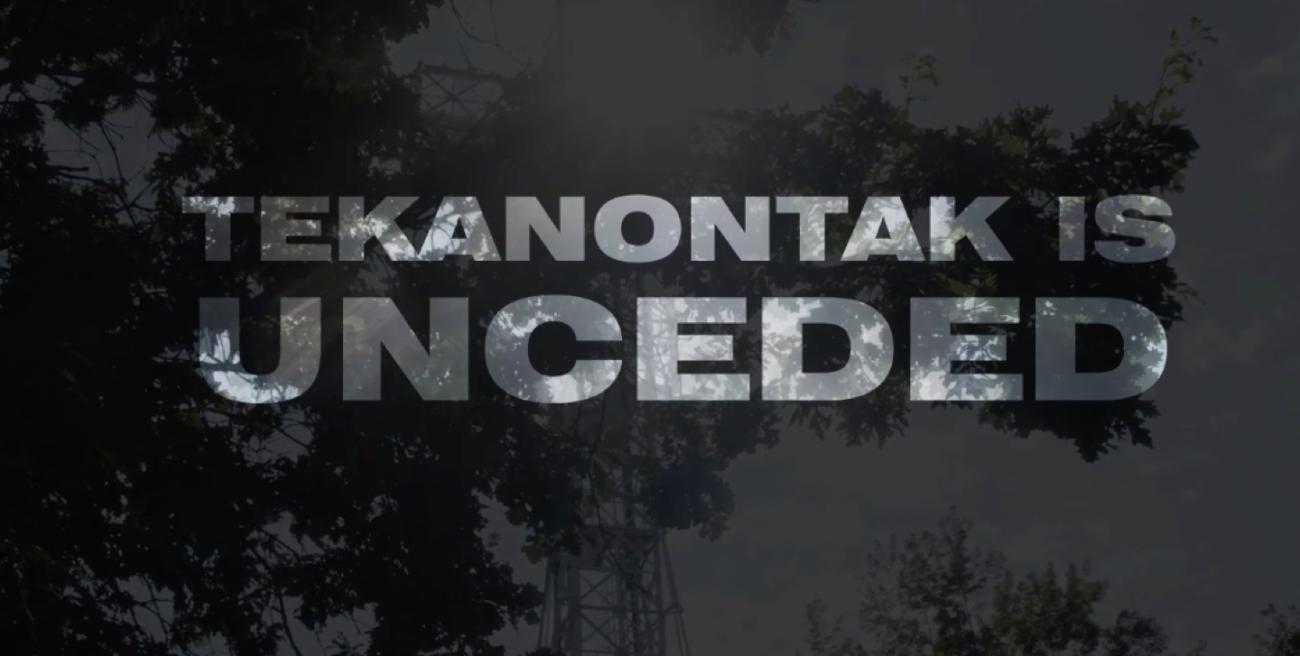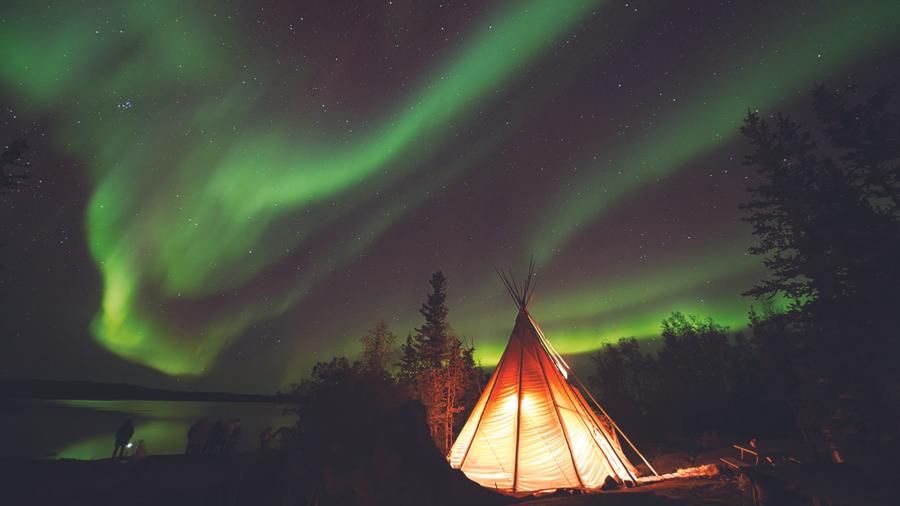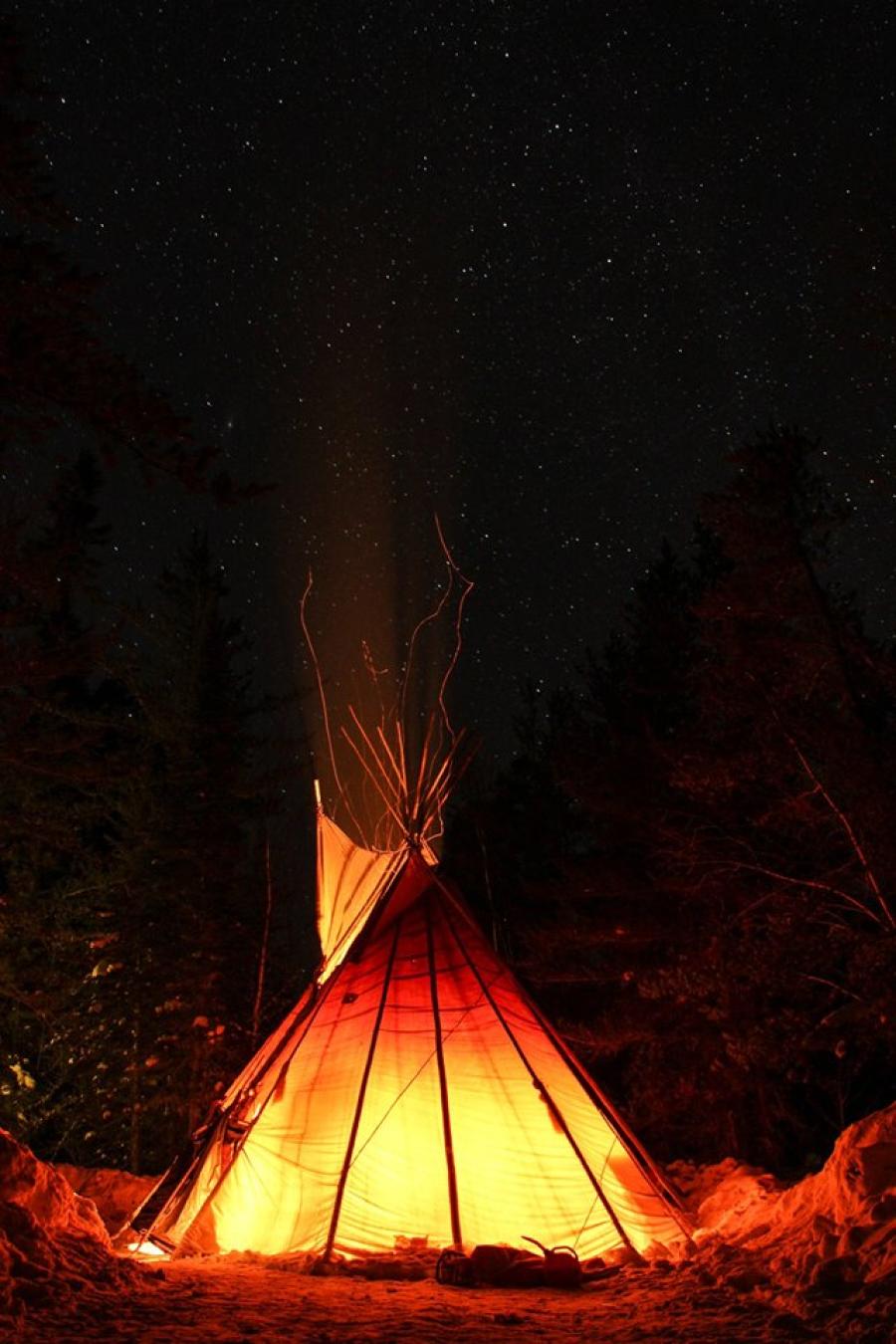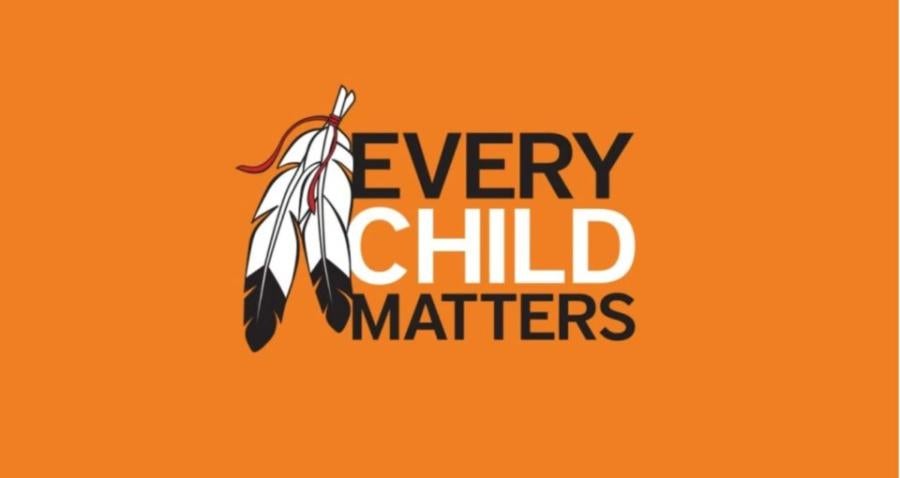
By the Take Back Tekanontak Committee in support of the kanien’kehá:ka kahnistensera (Mohawk Mothers)
Despite an ongoing injunction in court by the kanien’kehá:ka kahnistensera (Mohawk Mothers) against McGill University, Société des Infrastructure du Québec, ville de Montréal, et al. archeological excavation on sacred Indigenous sites have begun Tuesday, October 10, 2022. McGill refuses to follow the guidelines developed by the Truth and Reconciliation Commission (TRC) and by archaeologists engaged in searching for unmarked graves since the first findings in Tk’emlúps in 2021. As stated by these, “any work to locate missing Indigenous children must be led by Indigenous communities.” The upcoming intervention at the Royal Victoria Hospital is not led by Indigenous people, but rather by development promoters and a private firm they hired.
Since then, a temporary occupation by settler anarchists took place, the offices of Arkéos were vandalized by people claiming to act on behalf of the Mohawk Mothers (the action was condemned by the Mohawk Mothers and the solidarity committee), and a vigil by Divest McGill was held, surrounded by more police then there were citizens. Tensions are high in an extremely important case for Indigenous sovereignty on the island of Tiohtià:ke. The court hearing will be held on October 26, 2022, at the Montréal court. In order to better understand the situation, let us look back at the situation and how the tensions on Tiohtià:ke have built up since the Pope’s visit in July.
A Week of Apologies for Hundreds of Years of Abuse
Across territories of Indigenous Peoples in so-called Canada, the backlash of trauma was and continues to be felt by the express papal visit of July 24-29, 2022. Pope Francis' official apology was framed as an apology for the behavior of religious affiliates in residential schools without recognizing the church’s institutional role in cahoots with the federal government, which acted in a systematic manner, to undermine Indigenous ways of being. This common institutional strategy of blaming individual actors rather than taking responsibility for the core ideologies still salient in the church, and so many other institutions, only adds smoke to the smoke screens of an already aggravated political context of centuries of broken promises in a lingering colonial apparatus.
Despite the recognition of a "cultural genocide" by the Canadian authorities following the 2015 Truth and Reconciliation Commission, the Church still refuses to take responsibility for the consequences of the Catholic institution's genocidal mission in the public policies of Canadian federal state and provincial states colonial endeavors up to the 1990s, whose consequences are still very present. Faced with symbolic apologies and inaction, the reactions are mixed and many criticize the absence of responsibility or a work plan to “make things right”, as reported throughout the visit by APTN News.
In Tiohtià:ke (Montréal), the kanien’kehá:ka kahnistensera (Mohawk Mothers) held a press conference two days after the pope’s apology in Edmonton, at the foot of Tekanontak, under the continued smear of the Saint Jean Baptiste society’s cross overlooking the city of Montréal. This collective of Indigenous women from Kahnawa:ke – a Mohawk reserve on the south shore of Montréal – have been fighting for the recognition of unceded territories on and around the island of Tiohtià:ke for decades. They expressed their disbelief and feeling of emptiness following this apology. If the church and Pope Francis are “serious about making things right, [they] should start by revoking the Doctrine of Discovery”, said Kwetiio, spokesperson for the kanien’kehá:ka kahnistensera.
Their demands were clear: there is a need for these institutions to recognize their ongoing ideological tenets and to take action to reverse the settlers' imposition of a colonial ecology. On the island of Tiohtià:ke, this means symbolically, taking down the cross which continually “remind us of the horrors that we have lived and that we have survived”, says Kahentinetha. It also means, on a structural level, questioning the current dismissal and appropriation of the island by private corporations like McGill University and its project to transform the former Royal Victoria Hospital into a New Vic modernized facility for “sustainable development and public policy research” with 50 000 square meters right on the south flank of mount Tekanontak. It is for this reason that the Kahnistensera have recently gone to court “in a bid to block the start of excavation work”(For more information, see the release of the affidavits by the Kahnistensera, here).
Montreal and Colonial Heritage: Symbol and Reaction
The case of a city like Montréal based on the island of Tiohtià:ke is particularly relevant. The settlement of French colonizers on the island created the Eurocentric narrative of a transient Indigenous presence on the land, despite clear mapping and testimony of interactions over the centuries. It is understandable then that a cross raised high-up on the mount that once overlooked the multiple archeological sites of Indigenous villages continues to upset the kanien’kehá:ka kahnistensera that ask for its removal as survivors of residential schools.
When one starts digging, the veneer always scratches off from the surface with ease to reveal the underlying structure. The narrative of an abandoned island, and a cross that only testifies of settler perseverance and not colonial imposition of christianity, is yet again a direct attempt to forget the complex history of permanent presence, negotiations, warfare, and partial destruction of Indigenous Peoples.
If one initiates a forensic study of the archeology and architectural development of Montréal as a city on the island of Tiohtià:ke, one finds a completely different story. Affirming the absence of Indigenous people or Mohawk lineage on the island of Tiohtià:ke, is (i) a direct refusal to acknowledge the worldview and oral knowledge of the Mohawk people and the history of the Rotinonshón:ni confederacy, and (ii) a willful ignorance of the complexity of continued warfare, epidemics and movements of Indigenous populations occurring during the centuries of colonization in the midst of which Chomedey de Maisonneuve founded the city of Montréal.
The Rotinonshón:ni’s cosmology refutes ownership of land as they consider that “we belong to the earth” in the same way as “we belong to our mother.” “The feminine principle having, in matrilinear Peoples, an intrinsic link to land”. This definition of humans as linked and belonging to the earth also breaks the ethnic lineage to one of specific characteristics of a land and of a way of living on it, i.e., the logics through which we inhabit a given land (the definition of ecology – eko (habitat), logos (logic)). The very nature of lineage is therefore completely different as it is based on an ethical belonging that is transcribed both in the characteristics of a land but also in the animal’s spirit to which one belongs in a clan. This explains in great part the fragmented and extremely mobile networks that constitute Indigenous Peoples’ way of life on Turtle Island and their mixing beyond “national” belonging that revokes the modern conception of communitarian enclosure associated with birth (Natio) blood rights on a given territory.
In ignoring this oral history, the compressed Mohawk’s claim now needs to justify its political and legal arguments under the requirements of the settler’s ecology. Such refusal to recognize the other’s ecology documents the history of Montréal and Québec’s modern foundations. For many decades, Québec nationalism considered itself a victim of the British colonizers, and ever since built its relation to the land and Indigenous people through the invisibilisation of their struggle: the Indigenous were the federal government’s affair and not the real victims of colonization, as the Québecois considered themselves a minority overwhelmed and conquered by the Anglo-Saxon majority.
The separatist and nationalist movement was confronted to this contradiction when it took the path, following decades of fragmentary resistance through the Front de Libération du Québec (FLQ), of “converting their separatism into sovereignism” in the wake of the 1970s economic crisis. Abandoning the fragmented minority of its initial separatist struggle, the Québec nationalism grew into a majoritarian ambition of achieving “logistico-institutional” independence by “conquering the forces of nature.” These numerous development projects were instrumental in the blackmailing and invisibilisation of Indigenous communities and their ways of life.
Finally, observing the developmental blackmailing in the upsurge of Québec’s national industrialization can help us to better understand Montréal’s modernization process. The documentary Main basse sur la ville reveals how during the 1970s, Montréal’s historical neighborhoods were destroyed with just as little care or consideration as for original archeological testimonies of Indigenous presence. Through the accumulated wealth stolen from the colonized African countries, Montréal’s skyscrapers were being built by the same European financiers and State funded colonial corporations that were ravaging the world economically and ecologically.
The development of Montréal in the 1970s was never intended to ameliorate the lives of the citizens of settler societies, let alone that of Indigenous Peoples parked in reserves nearby. The constant speculation on land to perpetuate the expansion of an unlivable way of life is still a financial game in the hands of a few families in Montréal. A concrete prison continues to be raised, drowning the history of the island.
New Vic Project: Re-inhabiting the Colonized Space
The New Vic Project is a perfect representation of a refusal from the public and private institutional powers to re-think the model on which they stand in the settler metropolis of Montréal. The institution of McGill, founded by a fur trader turned land speculator and slave owner, Montréal’s richest citizen, holds an endowment of $1,892 billion (as of April 30, 2021), and its wealthy industrial donors and fossil fuel-friendly board members continue to finance an economy that keeps refusing any space for Indigenous ecologies and perpetuates the extractivist denial of settler societies.
The validation of the New Vic project as part of the Québec government’s $787 million financing for renovation of post-secondary educational institutions, stands firm in the tradition of developmental blackmail. Despite claiming in the seven directing principles of the project that it will “recognize the Indigenous past [and not the present] of the New Vic location and honor it” (as a fifth principle), the project reasserts the hegemony of the settler ecology on the land of Indigenous Peoples by claiming as a first and foremost principle that it is a project “for Montréal, Québec and Canada”, not the Indigenous. Its research program focuses on building a “unique expertise in science and engineering for sustainable development with the humanities and public policy making, to turn knowledge into action.”
Not once does it give way to actual Indigenous knowledge or ways of life, to considering their seminal and historical importance in the preservation of a liveable and sustainable environment on the island of Tiohtià:ke, Kanien’kehá:ka land and so-called Canada. The full hypocrisy of the veneer of reconciliation is at work in every page of the New Vic project and its public announcements. From superficial acknowledgment statements, to promises of “respectful relations to Indigenous Peoples” and embedding “Indigenous themes'' in the project, the message is clear: Indigenous presence is a past motif that only merits to adorn the walls of a brand new development project as memories of a bygone era. In this way, we move from firsting to lasting.
1 – Allen Memorial Institute (AMI). 2 – The stables of the AMI where most of the lethal experiments of alleged criminal Dr. Ewan Cameron took place. 3, 4 & 5 – Demanded excavation zones for potential unmarked graves of children killed during the Mk-Ultra psychiatric experiments. A – New Vic Project area and location of multiple potential archeological sites as analyzed by Arkeos for the OMCP public consultation. B – Buildings planned for demolition for the New Vic Project.
If the New Vic project truly aimed at tackling “the biggest issues of our time by thinking outside the box” in the words of principal and vice-chancellor Suzanne Fortier, then let us propose a series of concrete Indigenous knowledge that turns directly into action. We need solutions that can fulfill the publicly acknowledged need for serious reconciliation and reparation of our Peoples.
Building on the Indigenous ecology we have described along the way, we can imagine how reparations can truly be enacted in this particular context. As settler societies only begin to accept the persistent existence of the “other” – those ungovernable and fragmented Peoples that do not own this land but are a part of it – a shift needs to occur to allow for a middle ground to exist. If settlers – once migrants, before clouding their minds with illusions of discovery, ownership, and destiny upon this land – accept to listen and give living space to other ecologies, then perhaps the successive betrayals of the past treaties can be overcome and the twofold-cheater attitude rejected and condemned.
To do so one must first cease to systematically force the “other” into one’s own intellectual framework. This can only be accomplished if we are willing to make things right by returning lands and listening to legitimate calls from Indigenous Peoples to return great parts of the territory we claim to own, back to their traditional ways.
Returning back to traditional ways means to reinstate a value system that measures the wealth of a given community according to the health of its habitat, and the success of its members by the solidity of the relations nurtured within the community and living beings of our environment. The words of Tekarontakeh a kanien’kehá:ka Elder during the book launch of the Mohawk Warrior Society: A Handbook on Sovereignty and Survival strengthens this statement, and what is at the heart of reclaiming Indigenous ways of life:
“We did not make citizens of anyone, we made you equals and this is what should be taking place around the world. It should not be, small groups of people to decide. This is why we have been fighting, we know about that way of life, we know about these teachings, we continue to adhere to it in the best way we can, but we are constantly being oppressed, we are constantly having this genocide committed."
What is being asked here, is to reclaim, that is “to reappropriate or rehabilitate something that has been partially lost, or denied so as to be modified by this new learning.” At the heart of Tiohtià:ke this can be accomplished if we listen to the demands of the kanien’kehá:ka kahnistensera. As clan mothers, they hold through the Woman nomination belt (Ka’shastnsera Kontihwe Ne Iotiian:shon) a responsibility on unceded territory that forms a legitimate legal and political claim on Tiohtià:ke.

Hence, in solidarity with the kanien’kehá:ka kahnistensera and following some of their long-running demands, we offer as a committee a series of short and long-term proposals to overcome the settler’s ecology embedded in the New Vic project and to call for action to implement a project that truly responds to the need of making things right. This can only be a first step towards actions and means to reinstate a way of life embedded in the kanien’kehá:ka land on which Montréal currently resides.
If we are to act according to our words and respect the original agreements on which Indigenous Peoples, specifically of the Rotinonshón:ni confederacy in the case of Tiohtià:ke, welcomed us on Anowarà:ke (Turtle island), then we must first and foremost consider how to rehabilitate the Tehiohate (Two Row Wampum), the Rotinonshón:ni protocol and alliance belt for relationships with settlers.
This agreement, first made with the Dutch settlers, then the English and French, helps understand the agreement under which migrants have been welcomed onto this land: as ships on a river we are to move and live side by side as communities to “remain parallel” and refrain from crossing on the other’s way of life. As Philippe Blouin explains: “This paradoxical conception of alliance through separation not only applies to relationships with settlers, but between any and all social groups, including non-human nations, ensuring their mutual respect in diplomacy.”
On the island of Tiohtià:ke and its surroundings, this would signify a way of renegotiating land on a colonized space to give back parts of the island to an Indigenous presence that could form a networked ecology of non-sedentary paths from Kahnawa:ke to Tekanontak, to Kahneseta:ke and beyond. Such a renegotiation would reinstate the row of Indigenous land and the eastern gate of the Rotinonshón:ni confederacy.
Removing the cross from Tekanontak, returning the mount to kanien’kehá:ka care, and enacting land heritage out of the dispossessions made by theft would be a first step. The next would be to conceive of new legal, economic, and social checks and balances for a two row development of ways of life on the territory, from Montréal to Québec, to Canada giving way to a two-sided land with equal territories for Tiohtià:ke, Rotinonshón:ni and Indigenous Peoples in general.
To do this, however, we must begin locally by researching how one may reconsider urbanity, institutions, and territory beyond the sole imposition of a settler’s ecology.
Landscape and Sovereignty in Solidarity with Kanien’kehá:ka Kahnistensera
The most urgent local demands arise from the twofold cheater’s trap of a project like the New Vic. If McGill truly wished to implicate and acknowledge Indigenous land then they would follow consequential proposals such as these:
- A first short term response would be to help conduct a full external enquiry on the grounds of the Allan Memorial Institute and the Royal Victoria Hospital. This investigation using forensic tools such as those proposed by Forensic Architecture, would study the allegations of unmarked graves and of multiple archeological sites presumed to be there by the Arkeos report.
- A second short-term response would be to establish, under the initiative of the kanien’kehá:ka kahnistensera, a longhouse location to serve as an archival and cultural center in the tradition of the Rotinonshón:ni confederacy. If the cross is removed, mount Tekanontak could become a key part of the process of making things right here on the island of Tiohtià:ke.
- On a more long-term approach, if McGill were to accept a real external enquiry and give the land back to a “public domain” entrusted to kanien’kehá:ka people in order to set up an architectural project based on the guidance of archeological research established during the public consultation, McGill would finally “anchor” its project into the collectivity whilst reconciling with the Indigenous people that it systematically ignores when it states that it wishes to interact with the collectivity of “neighbors, Montréalers, Québécois, and Canadians”, failing once again to identify the presence of kanien’kehá:ka Peoples, despite acknowledging it was their land a few pages earlier.
The reality is that private institutions like McGill as much as public ones like the city of Montréal, still do not wish to consider their role to make things right as one of actual actions in reparation. Real long-term solutions, like giving research funds and land, currently owned and managed by McGill to kanien’kehá:ka people to transform the worded desires of “acknowledgment and reconciliation” into concrete actions, keeps on never occurring. The hypocrisy of the extractivist denial is more salient than ever in the attitudes and proposals of the New Vic project and the way McGill as much as the public institutions have handled it.
On this island of passage, where Indigenous nomads, migrant workers, and wandering souls have resided, and where in the past, smoke signals regularly informed the surrounding Rotinonshón:ni territories with news from the eastern gate, a signal was sent to all the Peoples of Anowarà:ke (Turtle Island). To remind those who woefully forget, that the irresolution of unceded lands on the island of Tiohtià:ke and its surroundings cannot be ignored. Action to restore ways of life that coincide once more with the earth and the two row wampum to which us settlers gave our word only to betray it, must take place once more to find a way out of a society that has passed the point of no return in climate doom and ecological collapse.



